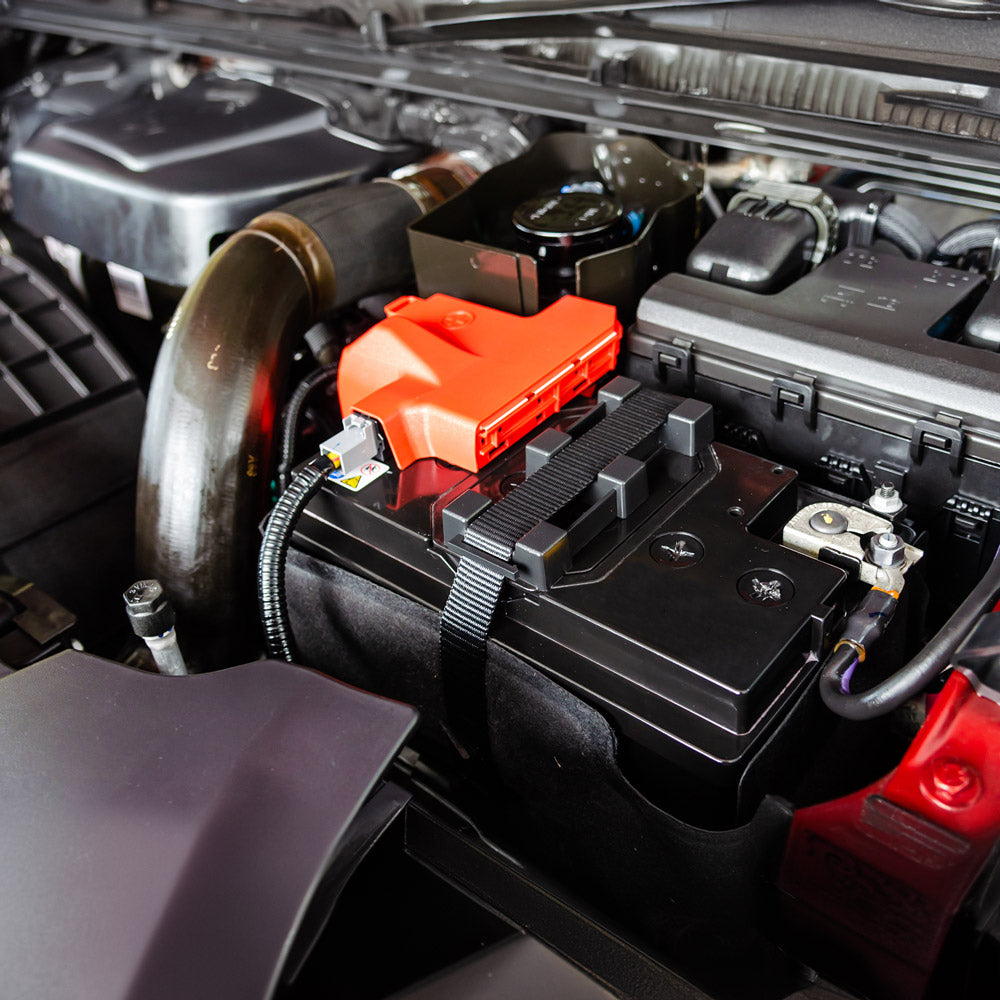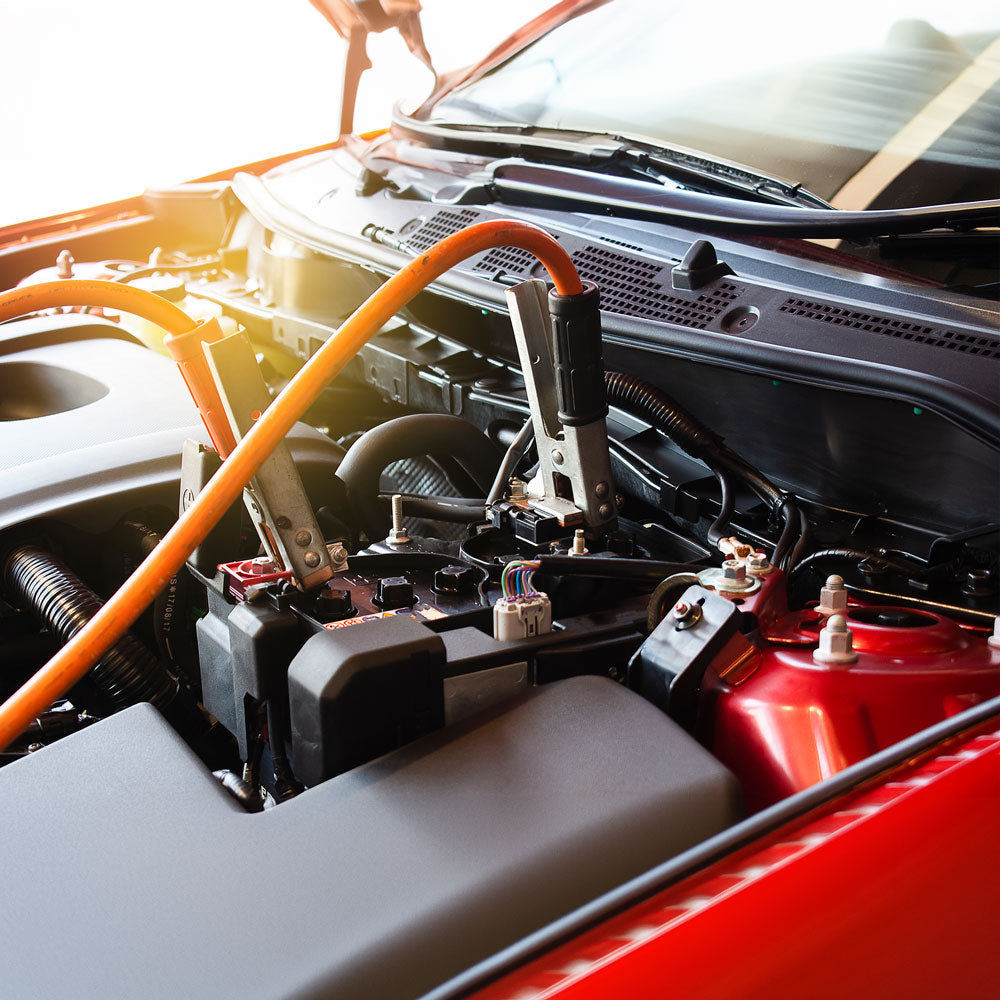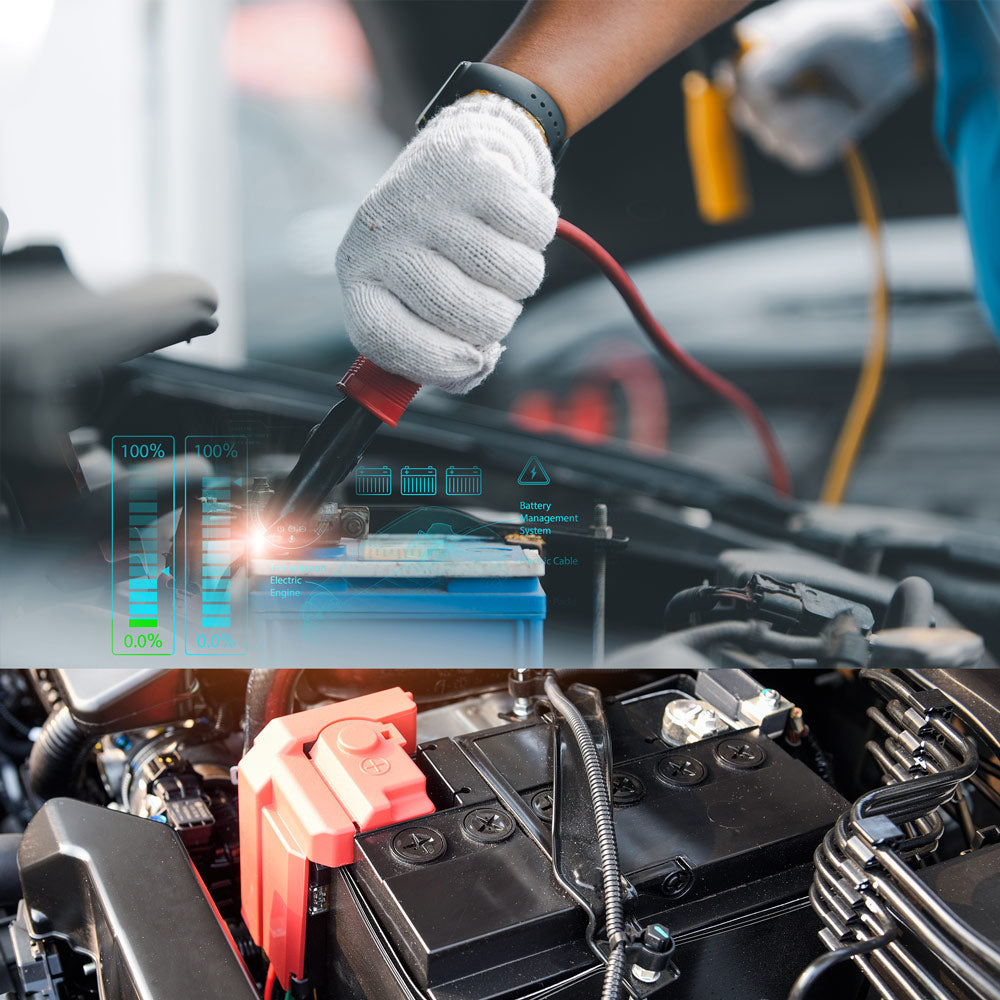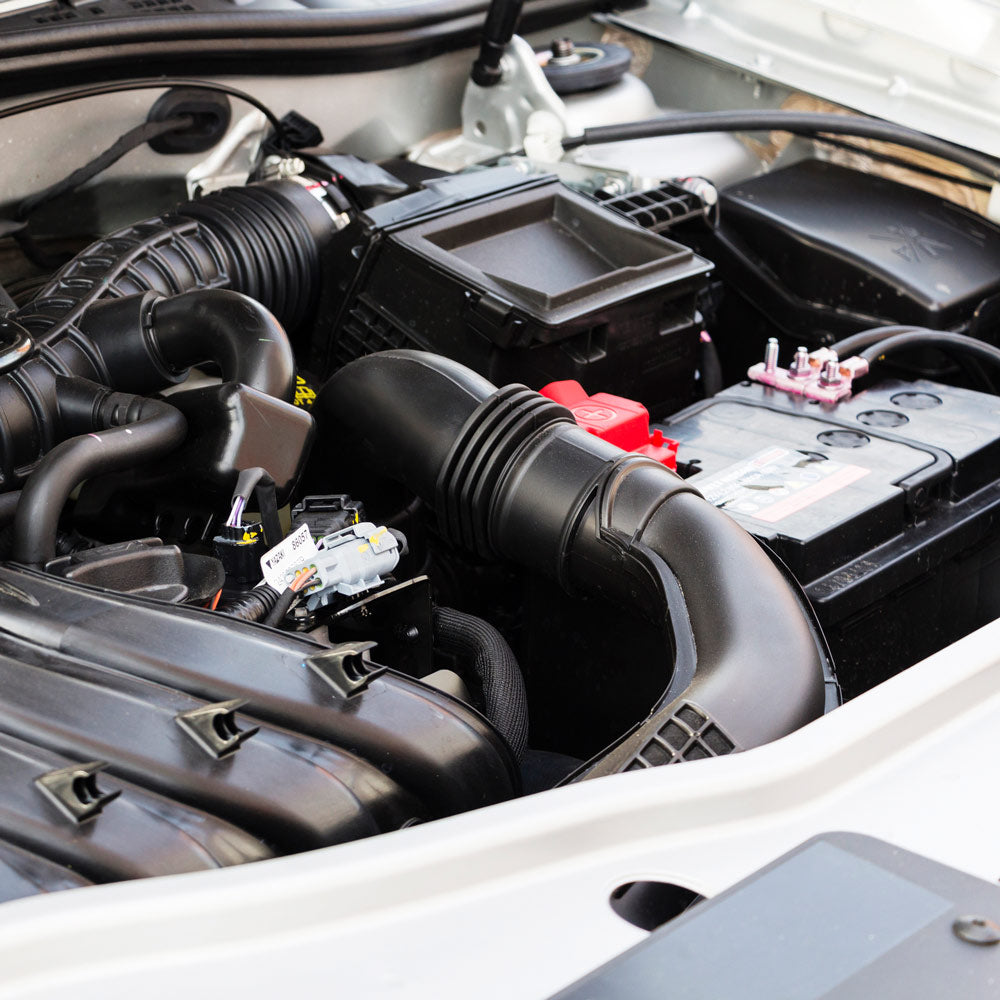

Weshalb ein Batteriecomputer für eine Autobatterie nützlich ist?
Ein Batterietestgerät ist nützlich, um die Widerstandsfähigkeit und Leistung von 12 Volt Batterien zu maximieren. Ein KFZ Batterie Wächter überwacht kontinuierlich den Zustand der KFZ Batterie und warnt bei niedriger Spannung. Der Einsatz eines KFZ Batteriewächters mit Bluetooth verhindert Tiefentladungen und sorgt dafür, dass die 12 Volt Batterie immer einsatzbereit ist. Ein Batterietester bietet Sicherheit und Zuverlässigkeit für jede KFZ Batterie.
Weshalb ein Batteriecomputer für eine Autobatterie nützlich ist?
Ein Batterietestgerät ist nützlich, um die Widerstandsfähigkeit und Leistung von 12 Volt Batterien zu maximieren. Ein KFZ Batterie Wächter überwacht kontinuierlich den Zustand der KFZ Batterie und warnt bei niedriger Spannung. Der Einsatz eines KFZ Batteriewächters mit Bluetooth verhindert Tiefentladungen und sorgt dafür, dass die 12 Volt Batterie immer einsatzbereit ist. Ein Batterietester bietet Sicherheit und Zuverlässigkeit für jede KFZ Batterie.

Batteriecomputer per WLAN & Bluetooth
Weltweite Datenübertragung kostenlos per WLAN - keine fortlaufenden Mobilfunkkosten
Energie- & Akkuüberwachung
Stromverbrauch (Ampere) und Batteriespannung (Volt) aller Bootsbatterien jederzeit und überall überwachen
Batteriestatus global prüfen
Abruf der Batteriewerte von Ihrem Boot weltweit per App
Umgebungsmonitoring
Erfassung von Umgebungsparametern wie Temperatur, Luftfeuchte und WLAN-Status
.
Produkt

Deine Vorteile mit unserem KFZ Batteriewächter
Ein Batteriecomputer für Autos & Fahrzeuge:
✓ Sicherheitssteigerung: Echtzeitüberwachung der Batterieparameter per Bluetooth und Temperatursensor verhindert potenzielle Gefahren und erhöht die Sicherheit an Bord.
✓ Optimierte Energieeffizienz: Präzise Daten zur Batteriespannung ermöglichen eine Anpassung der Energieverbrauchsmuster zur Effizienzsteigerung.
✓ Längere Batterielebensdauer: Vermeidung von Über- und Tiefentladung sorgt für eine längere Nutzungsdauer der Autobatterie sowie Batterieleistung.
✓ Benutzerfreundlich und zugänglich: WLAN-gestütztes Remote Monitoring und -steuerung erleichtert den Gebrauch, selbst fernab vom Automobil oder Lager.
✓ Langfristige Kosteneinsparungen: Effizientes Batteriemanagement reduziert Austauschkosten und optimiert den Energieverbrauch, was zu finanziellen Einsparungen führt.
Deine Vorteile mit unserem KFZ Batteriewächter
Ein Batteriecomputer für Autos & Fahrzeuge:
✓ Sicherheitssteigerung: Echtzeitüberwachung der Batterieparameter per Bluetooth und Temperatursensor verhindert potenzielle Gefahren und erhöht die Sicherheit an Bord.
✓ Optimierte Energieeffizienz: Präzise Daten zur Batteriespannung ermöglichen eine Anpassung der Energieverbrauchsmuster zur Effizienzsteigerung.
✓ Längere Batterielebensdauer: Vermeidung von Über- und Tiefentladung sorgt für eine längere Nutzungsdauer der Autobatterie sowie Batterieleistung.
✓ Benutzerfreundlich und zugänglich: WLAN-gestütztes Remote Monitoring und -steuerung erleichtert den Gebrauch, selbst fernab vom Automobil oder Lager.
✓ Langfristige Kosteneinsparungen: Effizientes Batteriemanagement reduziert Austauschkosten und optimiert den Energieverbrauch, was zu finanziellen Einsparungen führt.

Batteriemanagement mit WLAN + Batteriemonitor
Der HOOTS Batterietester mit WLAN und Batteriemonitor mit Anzeige bietet eine innovative Lösung für Autos und Fahrzeuge. Diese fortschrittliche Technologie ermöglicht eine präzise Kontrolle und Verwaltung der Batteriespannung auf einen Blick. Hersteller setzen auf diese Methode, um die sichere und effiziente Energieversorgung in Fahrzeugen zu gewährleisten. Live Daten und eine Langzeit Auswertung bieten detaillierte Einblicke in die Leistungsfähigkeit der Autobatterie und Automobil Batterie, wodurch die Zuverlässigkeit der Batterien erhöht wird.

Einsatz in 12 Volt Fahrzeugen und Automobilen
Effizientes Batteriemanagement ist in Fahrzeugen unverzichtbar, da die Energieversorgung für den Betrieb entscheidend ist. Ein WLAN-fähiges Batterieüberwachungsgerät ermöglicht eine bequeme und effektive Anwendung der Energiequellen. Ein solcher Wächter mit Bluetooth gewährleistet maximale Sicherheit und Zuverlässigkeit im Auto, verhindert Startprobleme und liefert zuverlässige Ergebnisse. Die Empfehlung ist klar: Investieren Sie in ein hochwertiges Überwachungssystem.
Einsatz in 12 Volt Fahrzeugen und Automobilen
Effizientes Batteriemanagement ist in Fahrzeugen unverzichtbar, da die Energieversorgung für den Betrieb entscheidend ist. Ein WLAN-fähiges Batterieüberwachungsgerät ermöglicht eine bequeme und effektive Anwendung der Energiequellen. Ein solcher Wächter mit Bluetooth gewährleistet maximale Sicherheit und Zuverlässigkeit im Auto, verhindert Startprobleme und liefert zuverlässige Ergebnisse. Die Empfehlung ist klar: Investieren Sie in ein hochwertiges Überwachungssystem.

Hauptmerkmale und Vorteile
Batterieüberwachung auf Top-Level
Alle Features und wichtige Funktionen unseres Batteriemanagementsystems für Fahrzeuge im Überblick
WiFi / WLAN-Kompatibilität
Ermöglicht das Remote-Monitoring und die Steuerung der Autobatterien über Smartphone, Tablet oder Computer. Anwender können den Batteriestatus in Echtzeit mittels eines Batteriemessgeräts prüfen und Einstellungen bequem aus der Ferne anpassen.
HOOTS Automobil Batterieüberwachung
Nutzer können den Batteriestatus mithilfe eines Auto-Bordcomputers mit Anzeige in Echtzeit überprüfen und Einstellungen bequem aus der Ferne anpassen. Empfehlung: Dieser Artikel bietet eine gratis App, um Batterieprobleme effizient zu verwalten.
HOOTS Echtzeit-Benachrichtigungen mit Alarm
Der KFZ Batteriemessgerät informiert Nutzer bei kritischen Batteriezuständen wie Überladung, Tiefentladung oder ungewöhnlichen Temperaturveränderungen.
HOOTS Datenaufzeichnung- und analyse
Mit der Messung und Langzeitaufzeichnung von Daten können Nutzungstrends und Muster der Autobatterien analysiert werden, um deren Haltbarkeit gezielt zu optimieren.
Eingliederung in vorhandene Systeme
Das System lässt sich mühelos in vorhandene Energieinfrastrukturen integrieren, einschließlich Solarpanels, Generatoren und Wechselrichtern. Diese nahtlose Nutzung gewährleistet optimale Betriebstemperatur und präzise KFZ Batterie Daten.

Fahrzeug 12 Volt Batterien auf Performance-Niveau überwachen
Unsere Lösung für ein Energiemanagementsystem mit Anzeige in Autos bietet eine zuverlässige und benutzerfreundliche Möglichkeit, den Batteriezustand zu überwachen.
Dank präziser Echtzeitdaten zu Spannungswerten, Kapazität und Ladezustand stellen Batteriemonitore sicher, dass Ihre Batterien stets optimal funktionieren. Die integrierte Bluetooth-App ermöglicht eine bequeme Kontrolle der Daten sowie Fernabfrage mit direkten Benachrichtigungen auf Ihrem Smartphone. Ein Temperatursensor überwacht die Leistungsfähigkeit und die Strom- sowie Datenübertragung.
Fahrzeug 12 Volt Batterien auf Performance-Niveau überwachen
Unsere Lösung für ein Energiemanagementsystem mit Anzeige in Autos bietet eine zuverlässige und benutzerfreundliche Möglichkeit, den Batteriezustand zu überwachen.
Dank präziser Echtzeitdaten zu Spannungswerten, Kapazität und Ladezustand stellen Batteriemonitore sicher, dass Ihre Batterien stets optimal funktionieren. Die integrierte Bluetooth-App ermöglicht eine bequeme Kontrolle der Daten sowie Fernabfrage mit direkten Benachrichtigungen auf Ihrem Smartphone. Ein Temperatursensor überwacht die Leistungsfähigkeit und die Strom- sowie Datenübertragung.


Echtzeitüberwachung der Batterie und Alarme für Automobile
Das System zur Batterieüberwachung mit SmartShunt in Autos liefert präzise Echtzeitdaten zur Spannung, Stromstärke und Ladekapazität Ihrer Akkumulatoren. Über eine intuitive Bluetooth-App auf Ihrem Smartphone haben Sie jederzeit Zugriff auf diese Informationen.
Damit behalten Sie mit einem WLAN Battery Guard Anschluss stets die Daten zum aktuellen Allgemeinzustand der Systemspannung, Entladung sowie Batteriekapazität Ihrer Fahrzeug-Batterien im Auge. Die Polkabellänge, Abschaltspannungswerte und Temperatur werden überwacht, was den Batterieschutz optimiert. Fernabfrage und Spannungswerte sorgen für eine umfassende Datenanalyse des Batteriezustands.
Echtzeitüberwachung der Batterie und Alarme für Automobile
Das System zur Batterieüberwachung mit SmartShunt in Autos liefert präzise Echtzeitdaten zur Spannung, Stromstärke und Ladekapazität Ihrer Akkumulatoren. Über eine intuitive Bluetooth-App auf Ihrem Smartphone haben Sie jederzeit Zugriff auf diese Informationen.
Damit behalten Sie mit einem WLAN Battery Guard Anschluss stets die Daten zum aktuellen Allgemeinzustand der Systemspannung, Entladung sowie Batteriekapazität Ihrer Fahrzeug-Batterien im Auge. Die Polkabellänge, Abschaltspannungswerte und Temperatur werden überwacht, was den Batterieschutz optimiert. Fernabfrage und Spannungswerte sorgen für eine umfassende Datenanalyse des Batteriezustands.


Lebensdauer mit KFZ Batterie-Wächter der Batterie verlängern
Durch präzise Batterieüberwachung Auto mit einem Voltmeter oder Amperemeter können Sie den Gebrauch Ihrer Batterien optimieren und ihre Einsatzfähigkeit per Überladungsschutz erheblich verlängern. Frühzeitige Warnungen bei kritischen Zuständen helfen, Tiefentladungen und andere schädliche Einflüsse zu vermeiden, die langfristig die Batterie eines Fahrzeugs beschädigen könnten. Ein Batteriemessgerät Auto mit Bluetooth ermöglicht eine effektive KFZ Batterieüberwachung und schützt die Autobatterie vor Entladung.
Lebensdauer mit KFZ Batterie-Wächter der Batterie verlängern
Durch präzise Batterieüberwachung Auto mit einem Voltmeter oder Amperemeter können Sie den Gebrauch Ihrer Batterien optimieren und ihre Einsatzfähigkeit per Überladungsschutz erheblich verlängern. Frühzeitige Warnungen bei kritischen Zuständen helfen, Tiefentladungen und andere schädliche Einflüsse zu vermeiden, die langfristig die Batterie eines Fahrzeugs beschädigen könnten. Ein Batteriemessgerät Auto mit Bluetooth ermöglicht eine effektive KFZ Batterieüberwachung und schützt die Autobatterie vor Entladung.

Fragen & Antworten
Wissenswertes über unsere Produkte im Bereich Automobile & Fahrzeuge
Bei welcher Spannung ist eine 12V Batterie tiefentladen?
Eine 12Volt Batterie gilt als tiefentladen, wenn ihre Spannung unter 10,5 Volt fällt. Dies kann erhebliche Schäden verursachen und die Nutzungsdauer der KFZ Batterie stark verkürzen. Um die Autobatterie vor Entladung zu schützen, ist ein Batteriewächter Autobatterie sehr nützlich. Solche Geräte überwachen kontinuierlich den Ladezustand der Fahrzeug Batterie und geben rechtzeitig Warnungen aus, wenn die Spannung kritisch wird. Ein Spannungsmesser als Gerät hilft, die Problematik der Tiefentladung zu verhindern, indem er die Autobatterie überwacht.
Wie kann ich feststellen ob eine 12V Autobatterie defekt ist?
- Spannung prüfen: Verwenden Sie ein Voltmeter, um die Spannung der 12 Volt Batterien zu messen. Liegt die Spannung unter 12,4 Volt, könnte ein Problem vorliegen.
- Belastungstest: Ein KFZ Batterie Wächter oder KFZ Batteriewächter kann den Zustand der Batterie unter Last testen. Fällt die Spannung unter 10 Volt, ist die Batterie wahrscheinlich defekt.
- Visuelle Inspektion: Überprüfen Sie die KFZ Batterie und den Stromkreis auf sichtbare Schäden oder Korrosion an den Anschlüssen.
- Auto Bordcomputer: Nutzen Sie den Auto Bordcomputer zur Kontrolle der KFZ Batterie.
Welche Spannung sollte eine 12V Autobatterie haben?
Eine 12Volt Autobatterie sollte im voll geladenen Zustand etwa 12,6 bis 12,8 Volt anzeigen. Um Ihre Autobatterie vor Entladung zu schützen und die Widerstandskraft zu maximieren, ist es wichtig, die Spannung regelmäßig zu überprüfen. Ein Batteriemessgerät für Autobatterie kann dabei helfen, die genaue Spannung zu messen und sicherzustellen, dass die KFZ Batterie stets optimal geladen ist. Die Anaylse der Autobatterien kann durch einen KFZ Batterie Wächter oder Batterietestgerät erfolgen, der bei niedriger Spannung warnt. So können Sie die Fahrzeugbatterie effektiv überwachen und Probleme frühzeitig erkennen. Ein zuverlässiger KFZ Batterie Wächter mit Daten Übertragung sorgt für eine längere Haltbarkeit der Batterie.
Wie lange muss man eine 12V Autobatterie laden?
Die Ladezeit einer 12Volt Autobatterie hängt von der Kapazität und dem Ladestrom ab. Normalerweise dauert es etwa 10-12 Stunden, um eine vollständig entladene Batterie bei einem Ladestrom von 10 Ampere aufzuladen. Um die Autobatterie vor Entladung zu schützen und optimal zu überwachen, ist es wichtig, den Ladezustand regelmäßig mit Wiederkehr zu überprüfen. Ein Spannungsmesser für Autobatterie kann dabei helfen. Achten Sie darauf, dass die KFZ Batterie im richtigen Betriebsspannungsbereich und bei der richtigen Betriebstemperatur geladen wird. Dies stellt sicher, dass die Datenübertragung korrekt ist und die 12 Volt KFZ Batterie effizient arbeitet.
Wie prüfe ich mit einem Messgerät eine 12Volt Autobatterie?
- Anschließen: Verbinden Sie das rote Kabel des Messgeräts mit dem Pluspol und das schwarze Kabel mit dem Minuspol der KFZ Batterie.
- Spannung messen: Lesen Sie die Spannung ab. Eine vollgeladene KFZ Batterie sollte etwa 12,6 bis 12,8 Volt anzeigen.
- Datenübertragung: Überwachen Sie regelmäßig die Datenübertragung, um die KFZ Batterie vor Entladung zu schützen.
- Abschaltspannung: Achten Sie darauf, dass die Spannung nicht unter 10,5 Volt fällt, um die Nutzungsdauer zu maximieren.
- Autobatterie überwachen: Regelmäßige Überprüfung hilft, die Autobatterie effizient zu überwachen und zu warten.
Wie lange hält in der Regel eine 12V Autobatterie?
Eine 12Volt KFZ Batterie hält in der Regel 4 bis 6 Jahre, abhängig vom Gebrauch und Wartung. Um die Langlebigkeit zu maximieren, sollten Sie die Autobatterie regelmäßig überwachen und vor Entladung schützen. Ein gutes Messgerät mit ausreichender Polkabellänge hilft bei der Datenübertragung und Überprüfung der Spannung. Achten Sie darauf, dass die Entladeschlussspannung nicht unterschritten wird, um Schäden zu vermeiden. Für detaillierte Produktinformationen und optimale Pflegehinweise sollten Sie die Herstellerangaben beachten. Regelmäßige Wartung und Anaylse sind der Schlüssel zur Verlängerung der Batterielebensdauer.
Noch mehr Wissen
Wie lade ich eine 12 Volt Autobatterie?
- Ladegerät ausschalten: Stellen Sie sicher, dass das Ladegerät ausgeschaltet ist, bevor Sie es mit der Batterie verbinden.
- Verbinden der Kabel: Verbinden Sie das rote Kabel des Ladegeräts mit dem Pluspol (+) der Batterie und das schwarze Kabel mit dem Minuspol (-) der Batterie. Einige Ladegeräte verfügen über Klemmen, die direkt an die Batterie angeschlossen werden.
- Einstellen des Ladegeräts: Wenn Ihr Ladegerät über verschiedene Modi verfügt, wählen Sie den Modus, der am besten zu Ihrem Batterietyp und Ihrem Ladebedarf passt. Für eine Standardladung ist normalerweise ein niedriger Strom (z.B. 2 Ampere) für eine längere Dauer geeignet, während ein höherer Strom (z.B. 10 Ampere) für eine Schnellladung genutzt werden kann.
- Ladegerät einschalten: Schalten Sie das Ladegerät ein. Viele moderne Ladegeräte zeigen den Fortschritt des Ladevorgangs an und schalten sich automatisch ab, wenn die Batterie vollständig geladen ist.
- Überwachung: Überwachen Sie den Ladevorgang regelmäßig, um sicherzustellen, dass es zu keinen Problemen kommt. Moderne Ladegeräte sind zwar sicher und zuverlässig, aber eine gelegentliche Überprüfung ist dennoch ratsam.
- Ladegerät ausschalten und Kabel entfernen: Sobald die Batterie vollständig geladen ist oder das Ladegerät den Ladevorgang beendet hat, schalten Sie das Ladegerät aus, bevor Sie die Kabel entfernen. Entfernen Sie zuerst das schwarze Kabel vom Minuspol und dann das rote Kabel vom Pluspol.
Was passiert bei einer Batterie Tiefentladung?
- Schädigung der Batteriezellen: Bei Blei-Säure-Batterien, die in den meisten Fahrzeugen verwendet werden, führt eine Tiefentladung zur Sulfatierung der Bleiplatten. Dies bedeutet, dass Bleisulfatkristalle auf den Platten wachsen, was die Fähigkeit der Batterie, sich wieder aufzuladen, verringert.
- Reduzierte Kapazität: Eine tiefentladene Batterie kann ihre volle Kapazität verlieren. Die Batterie kann sich nicht mehr vollständig aufladen, was zu einer deutlich verringerten Leistung führt.
- Verkürzte Lebensdauer: Tiefentladung kann die Lebensdauer einer Batterie erheblich verkürzen. Während Batterien eine begrenzte Anzahl von Lade-/Entladezyklen haben, kann eine Tiefentladung dazu führen, dass diese Zyklen schneller erreicht werden.
- Interne Kurzschlüsse: Bei extremen Tiefentladungen können in einigen Batterietypen interne Kurzschlüsse entstehen, die die Batterie dauerhaft beschädigen und sogar gefährlich machen können.
- Probleme beim Wiederaufladen: Nach einer Tiefentladung kann es schwierig sein, eine Batterie wieder aufzuladen, da die normale Ladeelektronik möglicherweise nicht in der Lage ist, den Ladevorgang zu initiieren.
- Spannungsabfall: Die Batteriespannung kann so weit absinken, dass sie nicht mehr in der Lage ist, die elektrischen Systeme des Fahrzeugs adäquat zu versorgen, was zu Ausfällen oder Fehlfunktionen führen kann.
- Einfluss auf angeschlossene Elektronik: Bei Fahrzeugen mit vielen elektronischen Systemen kann eine Tiefentladung der Batterie zu Fehlern oder Störungen in diesen Systemen führen.
Austausch der Autobatterie: Was ist dabei zu beachten?
- Sicherheit: Tragen Sie immer Schutzhandschuhe und eine Schutzbrille, um sich vor Batteriesäure und Funkenbildung zu schützen.
- Fahrzeug ausschalten: Stellen Sie sicher, dass das Fahrzeug vollständig ausgeschaltet ist, bevor Sie mit dem Wechsel beginnen. Entfernen Sie den Zündschlüssel und stellen Sie sicher, dass keine elektrischen Geräte wie Radio oder Lichter eingeschaltet sind.
- Reihenfolge der Kabel: Beim Abklemmen der Batterie sollten Sie zuerst das Minuskabel (-) und dann das Pluskabel (+) lösen. Beim Anschließen der neuen Batterie verfahren Sie umgekehrt: zuerst Plus (+), dann Minus (-). Dies minimiert das Risiko eines elektrischen Kurzschlusses.
- Richtige Batterieauswahl: Stellen Sie sicher, dass die neue Batterie die richtige Größe und Spezifikation für Ihr Fahrzeug hat. Die Spannung (in der Regel 12 Volt) und die Kapazität (Ah) sollten mit den Angaben des Fahrzeugherstellers übereinstimmen.
- Batteriefach reinigen: Bevor Sie die neue Batterie einsetzen, reinigen Sie das Batteriefach und entfernen Sie eventuelle Korrosion mit einer Bürste und einer Backpulver-Wasser-Lösung.
- Feste Verbindungen: Achten Sie darauf, dass die Kabelverbindungen fest und sicher sind, um eine gute elektrische Leitfähigkeit zu gewährleisten.
- Speichergeräte: Einige Fahrzeuge haben elektronische Systeme, die beim Abklemmen der Batterie ihre Speicher verlieren können. Überlegen Sie, ob ein Memory-Saver oder eine externe Stromquelle notwendig ist, um diese Einstellungen zu erhalten.
- Entsorgung der alten Batterie: Alte Autobatterien enthalten gefährliche Chemikalien und müssen umweltgerecht entsorgt werden. Viele Werkstätten oder Recyclinghöfe nehmen alte Batterien zur fachgerechten Entsorgung an.
- Überprüfung nach dem Wechsel: Nach dem Einbau der neuen Batterie sollten Sie das Fahrzeug starten und überprüfen, ob alle elektrischen Systeme ordnungsgemäß funktionieren.
- Anlernen der neuen Batterie: Bei einigen modernen Fahrzeugen muss die neue Batterie im Fahrzeugsystem angelernt werden. Dies kann erforderlich sein, um die korrekte Funktion des Batteriemanagementsystems zu gewährleisten.

Jetzt bestellen und Lebensdauer der Batterie verlängern
Zum BatteriewächterDHL Versand innerhalb Europas
Versand per DHL auch an Packstation / Postfiliale und europaweit
Kundenservice
Haben Sie Fragen? battery@hoots.de
HOOTS Empfehlen
Sie möchten HOOTS BATTERY auf Ihren Social Media Kanälen z.B. YouTube vorstellen oder vertreiben? battery@hoots.de
Sichere Bezahlmethoden
Apple Pay | Google Pay | PayPal | Klarna Rechnung | Visa | Mastercard | Vorkasse
